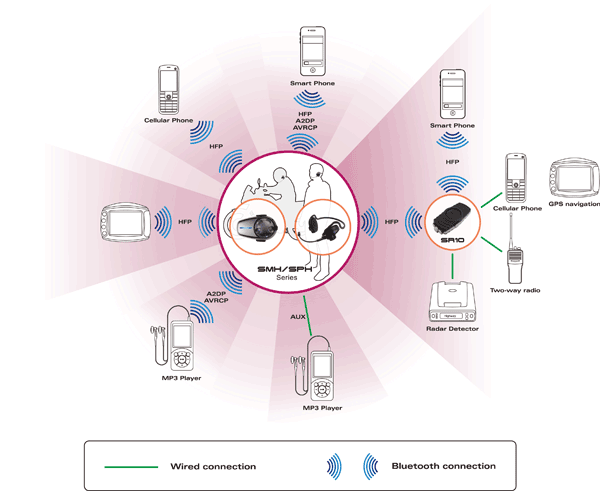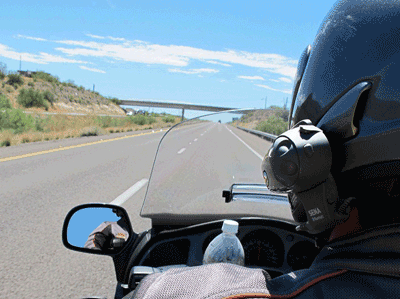Against the wind – Part 2: The unexpected uses of Bluetooth for motorcycles
Bluetooth for motorcycles is proffered as a way to communicate privately with other riders or just relax with some tunes piped into your helmet – but there is an unexpected advantage
By Paul O’Shea
Sr. Editor
Electronic Products Magazine
Part 1 ( http://tinyurl.com/cmbdrgs) talks about how we have communicated on motorcycles and how far technology has taken us
Bluetooth technology started off slowly after its introduction but has found its way into the mainstream with cell phones and Bluetooth headsets leading the way of commonly used pairings. We also see pairings of printers and cameras, cell phones through car audio, and connections for motorcyclists between driver and pillion passenger, or even between separate motorcycles.
I recently took a motorcycle trip on a BMW k1200LT and used a Sena SMH10 (www.SenaBluetooth.com) Bluetooth communication device. In a word, wow! This is light years ahead of all the previous devices described. Not only can these systems communicate totally wirelessly from rider to passenger, they can be used to communicate from bike to bike. Since you must program two units to work together, you won’t pick up conversations from other people with Bluetooth devices. You don’t have to worry about your conversations being listened to by anyone else. Additionally, you can integrate with a Bluetooth enabled cell phone and automatically answer calls, hands free. You can enjoy your favorite stereo music from your A2DP enabled cell phone or MP3 player and listen to the audio navigation message from your Bluetooth enabled GPS.
Here’s what the interconnections looks like graphically, followed by what the system looks like on your helmet:

Bluetooth multiple interconnections

Sena SMH10 Bluetooth headset on the lower left of the helmet – the transmitter and battery connect to helmet with sturdy clamps – drilling holes not needed
The trip was about 2,000 total miles, taking two days to our destination in the Smokey Mountains near Asheville, NC and then two days back to FL. We started out with the excitement level high because we needed to outrun a tropical storm, which meant that our planned route of taking all back roads was changed to all interstate routes – until we were out of the rain bands. That storm eventually dropped up to 27-in over four days in some places in north Florida. Luckily, we got ahead of the storm and enjoyed peaceful driving on the back roads of Georgia and North Carolina.
The Sena Bluetooth system uses lithium polymer batteries and each full charge provides 14 hours of talk time, considerably longer than the 12 hours listed on the spec sheet. The clarity of the voice was crystal clear up to about 60 mph. Above 60 mph the road-noise and wind became an issue but were easily counteracted by turning up the volume via a large control wheel (easily turned with gloved hands). In addition to a cell phone, a GPS (which I don’t have), and a music device like an iPod, you can talk with up to three other people using Bluetooth devices. That last part, talking with other cyclists intrigues me because the communication can occur up to 1,000 yards apart (at high speeds) on flat roads and few obstructions (think Texas out in the country). The talk distance in cities or places with many obstructions will vary and I would appreciate any information from readers on how well it works. The Bluetooth connection means that you can have personal conversations with 3 other riders at the same time, or intercom each of them separately, without other people interfering. Those are all great but we found another important use for the Bluetooth device – safety.
As it happened, we returned home in just as exciting a situation as it was when we began. This time it was the temperature that was challenging because it was triple-digit hot. We were in temperatures of 113F, and that’s not considering the heat from the road and motorcycle engine. We started out in the mountains but the searing hot front was already moving in, and by the time it was late morning the temperatures was up near 100F and rising fast. We had plenty of water and stopped every couple hours but that wasn’t enough. My wife started to dehydrate and was only able to communicate, in a very weak voice, that she was feeling faint. This is a critical situation where you don’t have much time to respond and shoulder taps or hand motions aren’t possible. I was able to talk to her and keep her focused on my voice via the Bluetooth system, as we slowed down and pulled off the heavily trafficked road. The main lesson learned was to hydrate but also wear long sleeve shirts to keep the body from losing fluids so quickly. However, I like to think that technology helped keep this as a good vacation memory by providing a way to communicate quickly and offer a measure of safety.
Advertisement
Learn more about Electronic Products Magazine





